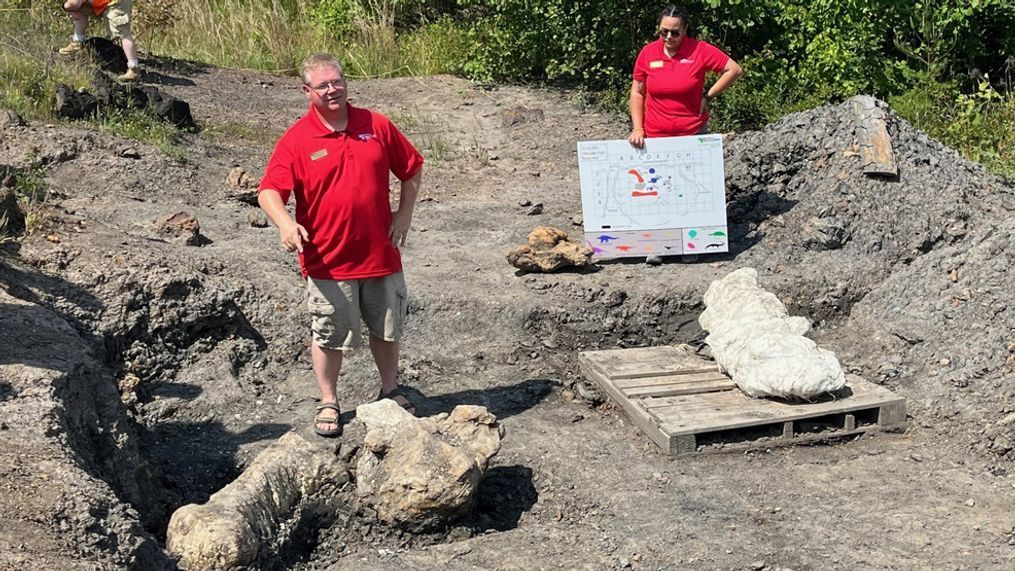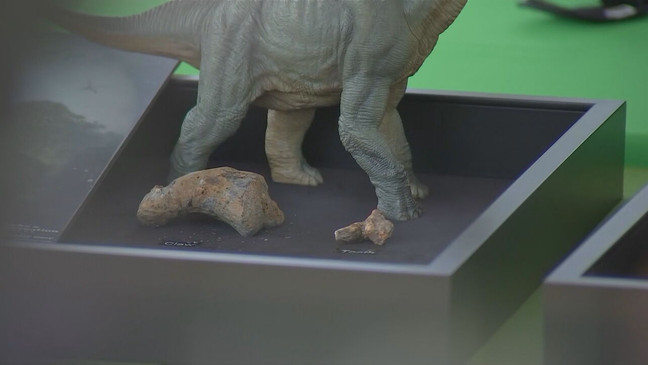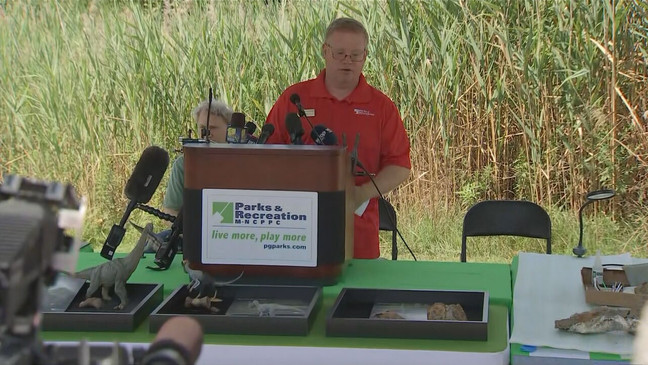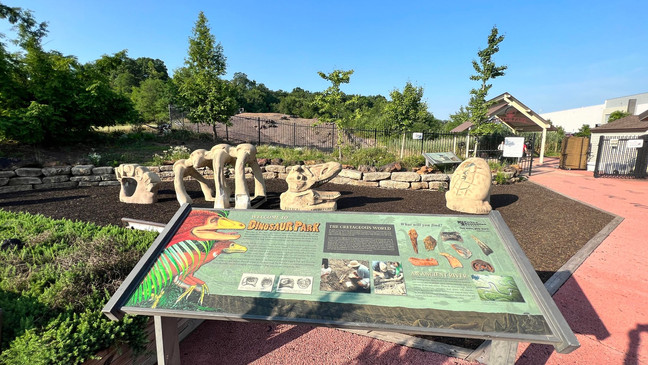First-of-its-kind dinosaur bones discovered at Laurel, Maryland park
LAUREL, Md. (7News) — A rare dinosaurbone bed was recently discovered at aLaurel, Maryland park, according to Prince George’s County Department of Parks and Recreation.
The host of bones was found atM-NCPPCDinosaur Park and officials said it's the first of its kind found in Maryland since 1887, marking a major milestone in paleontological research.Officials tell 7News that the term “bone bed” is used by paleontologists when bones of one or more species are concentrated within a geologic layer.
"Finding a bonebed like this is a dream for many paleontologists as they can offer a wealth of information on the ancient environments that preserved the fossils and provide more details on the extinct animals that previously may have only been known from a handful of specimens,” said JP Hodnett, M-NCPPC, Department of Parks and Recreation, Prince George’s County Dinosaur Park Paleontologists and Program Coordinator. “Most paleontologists have to travel across the country or go overseas to find something like this, so having this rare find so close to home is fantastic!"
The parks department held a Wednesday press conference announcing that the paleontologists believe they found a leg bone from Acrocanthosaurus.
You can watch thepress conferencebelow:
SEE ALSO |The dawn of a new age: Scientists declare new epoch, the Anthropocene
Hodnett made the initial discovery and classified the 3-foot-long shin bone as a therapod, a branch of the dinosaur family that contains carnivorous dinosaurs such as Tyrannosaurus rex. His initial hypothesis of this fossil is an Acrocanthosaurus, the largest theropod in the Early Cretaceous period, estimated to measure about 38 feet long. Acrocanthosaurus teeth have been previously collected from Dinosaur Park.
“Dinosaur fossils are exceptionally rare in the eastern US, and among these only Maryland has produced dinosaurs from the Early Cretaceous Period. Typically, only one or two bones are found at a time, so this new discovery of a bonebed of fossils is extremely important. It is certainly the most significant collection of dinosaur bones discovered along the eastern seaboard in the last hundred years,” said Matthew Carrano, a paleontologist with the Smithsonian.
University of Maryland Paleontologist Thomas Holtz, the first to verify the therapod discovery at the park, said “The dinosaur site at Laurel is by far the most important dinosaur dig site in America east of the Mississippi. It is historically significant, as it was one of the first dinosaur fossil sites found in the U.S. More importantly, it gives us insights into the diversity of animals and plants at a critical period in Earth's history.”
The first fossil found in the bonebed was a four-foot-long limb bone encased in ironstone of a large dinosaur, the identification is unknown at this time. Additional ancient plant and animal fossils found between 2018 to present include:
- Priconodon, a large, armored dinosaur, teeth, osteoderms, and vertebra
- Sauropod (Long Necked plant-eating dinosaur, 60-70 feet long), possibly Astrodon, one tail vertebra.
- Ornithomimoid, ostrich-like dinosaur, ankle bone, claw, and a vertebra
- Large theropod, possibly Acrocanthosaurus, 3-foot-long shin bone from a 35+ foot long meat-eating dinosaur.
- Deinonychus, a bird-like predatory dinosaur and larger Velociraptor-relative, tooth
- Small tyrannosaur, early T. rex relative and first evidence of this group in Maryland, potential oldest in Eastern North America, tooth.
- Small theropod (coelurosaur), chicken-sized meat-eating dinosaur and distant relative to T. rex, thigh bone.
- Crocodile, tooth.
- Turtle, multiple shell segments and limb bones, possibly more than one individual.
- Stingray, oldest North American fossil representative, 2nd oldest globally, tail barb.
- Coprolites- fossilized animal poops.
- Large freshwater clam.
- Large, carbonized conifer wood log segments.
- Carbonized seed cone clusters
“This discovery marks an extraordinary milestone in the field of paleontology and opens a window into the ancient world and species that once roamed this land millions of years ago.” said Peter A. Shapiro Chairman of The Maryland-National Capital Park and Planning Commission. “We are proud of our dedicated team of experts at the Department of Parks and Recreation, Prince George’s County and their ongoing efforts in preserving and studying our natural heritage.”
If all of this has ignited your interest in the Cretaceous period, the dinosaur park is open to the public twice a month and while you likely won’t find a huge meat eater bone, you will absolutely see fossils.
The park is at 13100 Mid-Atlantic Blvd Laurel, Maryland 20708. It is open to the public on the first and third Saturdays of each month. For $10 you can participate in a 3-hour program which includes instruction and excavation. You can find more information, here.




